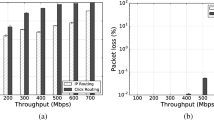Abstract
Virtual private networks (VPNs) provide customers with a secure and manageable communication environment. The allocation of bandwidth for VPNs to meet the requirements specified by customers is now one of the most important research issues in the field of traffic engineering. A VPN resource-provisioning model called hose-model was developed to provide customers with a flexible and convenient way to specify the bandwidth requirements of a VPN. Several hose-model VPN provisioning algorithms have already been proposed. They focus on the bandwidth efficiency issue in the case of establishing a single hose-mode VPN. However, these algorithms cannot achieve a satisfactory rejection ratio when: (1) the residual bandwidths on links of the network backbone are finite and (2) multiple VPN setup requests are handled on-line. In this paper, we propose a new hose-model VPN provisioning algorithm called MTRA to address the issue. MTRA can process multiple VPN setup requests rapidly and reduce the rejection ratio effectively. Theoretical upper bounds of rejection ratios achieved by several VPN provisioning algorithms are also derived. The experiments verify that MTRA performs better in regards to the rejection ratio than other provisioning algorithms.
Similar content being viewed by others
References
G. Italiano, R. Rastogi and B. Yener, Restoration Algorithms for Virtual Private Networks in the Hose Model, in: Proc. of IEEE INFOCOM (2002).
B.S. Davie and Y. Rekhter, MPLS Technology and Applications, Morgan Kaufmann, San Francisco, CA, 2000.
N.G. Duffield, P. Goyal and A. Greenberg, A Flexible Model for Resource Management in Virtual Private Networks, in: Proc. of ACM SIGCOMM (1999).
N.G. Duffield, P. Goyal, A. Greenberg, P. Mishra, K.K. Ramakrishnan and J.E.V.D. Merwe, Resource Management with Hoses: Point-to-Cloud Services for Virtual Private Networks, IEEE/ACM Transactions on Networking, 10(5) (2002) 679–692.
A. Kumar, R. Rastogi, A. Silberschatz and B. Yener, Algorithms for Provisioning Virtual Private Networks in the Hose Model, IEEE/ACM Transactions on Networking 10(4) (2002) 565–578.
A. Juttner, I. Szabo and Á Szentesi, On Bandwidth Efficiency of the Hose Resource Management Model in Virtual Private Networks, in: Proc. of IEEE INFOCOM (2003).
D.O. Awduche, J. Malcom, J. Agobua, M. O’Dell and J. Mcmanus, Requirement for Traffic Engineering over MPLS, IETF RFC 2702, Sep. 1999.
A. Gupta, A. Kumar and R. Rastogi, Exploring the Trade-off between Label Size and Stack Depth in MPLS routing, in: Proc. of IEEE INFOCOM, 2003.
A. Gupta, J. Kleinberg, A. Kumar, R. Rastogi and B. Yener, Provisioning a Virtual Private Network: A Network Design Problem for Multicommodity Flow, in: Proc. of the 33rdAnnual ACM Symposium on Theory of Computing (STOC) (2001).
C. Swamy and A. Kumar, Primal-Dual Algorithms for Connected Facility Location Problems, in: Proc. of the 5th International Workshop on Approximation Algorithms for Combinatorial Optimization (2002).
T.H. Cormen, C.E. Leiserson and R.L. Rivest, Introduction to algorithms, twentieth printing, MIT Press, 1998.
A. Balasubramanlan and G. Sasaki, Bandwidth Requirement for Protected VPNs in the hose model, in: Proc. of IEEE International Symposium on Information Theory (2003).
C.T. Chou, Traffic engineering for MPLS-based Virtual Private Networks, Computer Networks 44(3) (2004) 319–333.
K. Kar, M. Kodialam and T.V. Lakshman, Minimum Interference Routing of Bandwidth Guaranteed Tunnels with MPLS Traffic Engineering Applications, IEEE J. Selected Areas in Communications 18(12) (2000) 2566–2579.
M. Kodialam and T.V. Lakshman, Minimum Interference Routing with Applications to MPLS Traffic Engineering, in: Proc. of IEEE INFOCOM (2000).
S. Suri, M. Waldvogel and P.R. Warkhede, Profile-Based Routing and Traffic Engineering, Computer Communications 26(4) (2003) 351–365.
B. Wang, X. Su and C.L. Philip Chen, A New Bandwidth Guaranteed Routing Algorithm for MPLS Traffic Engineering, in: Proc. of IEEE International Conference on Communications (2002).
Yi Yang, L. Zhang, J.K. Muppala and S.T. Chanson, Bandwidth-Delay Constrained Routing Algorithms, Computer networks 42(4) (2003) 503–520.
G. Apostolopoulos, R. Guérin, S. Kamat and S. K. Tripathi, Server-Based QoS Routing, in: Proc. of IEEE GLOBECOM (1999).
S. Plotkin, Competitive Routing of Virtual Circuits in ATM networks, IEEE J. Selected Areas in Communications 13(6) (1995) 1128–1136.
E. Horowitz, S. Sahni and S. Anderson-Freed, Fundamentals of Data Structure in C, Computer Science Press, 1993.
A. Medina, A. Lakhina, I. Matta and J. Byers, BRITE: Universal Topology Generation from a User’s Perspective, http://www.cs.bu.edu/brite/publications/usermanual.pdf April 2001.
A. Medina, A. Lakhina, I. Matta and J. Byers, BRITE: An Approach to Universal Topology Generation, in: Proc. of the International Workshop on Modeling, Analysis and Simulation of Computer and Telecommunications Systems(MASCOTS), (Aug. 2001).
R. Guerin, D. Williams and A. Orda, QoS Routing Mechanisms and OSPF extensions, in: Proc. of IEEE GLOBECOM (1997).
Author information
Authors and Affiliations
Corresponding author
Rights and permissions
About this article
Cite this article
Liu, YL., Sun, Y.S. & Chen, M.C. MTRA: An on-line hose-model VPN provisioning algorithm. Telecommun Syst 31, 379–398 (2006). https://doi.org/10.1007/s11235-006-6724-2
Published:
Issue Date:
DOI: https://doi.org/10.1007/s11235-006-6724-2




